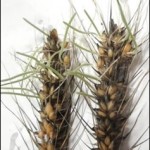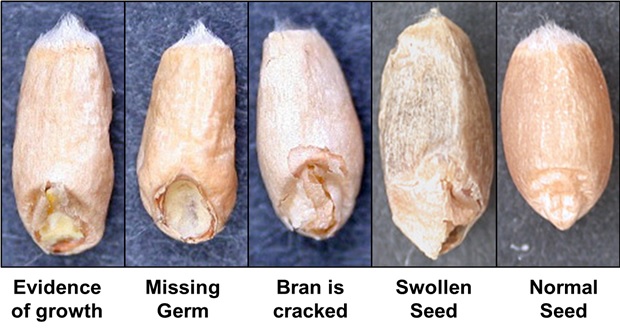by Clark Neely, Assistant Professor and Extension Agronomist
The weather for the 2014-2015 Texas wheat crop had many growers optimistic going into the harvest season with above average yields in many fields across the state. Unfortunately, excessive rains have already prevented some fields from being harvested in South Texas and lodging is quite common across the Blacklands. With continued chances of rain in the forecast, pre-harvest sprouting is another concern that many growers will have to deal with this year.
Pre-harvest sprouting in wheat is not a new phenomenon in Texas, but the number of potential acres affected this year could be very widespread compared to years past. Sprouting only becomes an issue once the crop has reached physiological maturity. Fortunately, regions of Southeast Texas and the Southern Blacklands did not reach maturity until 1-2 weeks ago, which provided protection against sprouting from the heavy rains received throughout April and most of May. However, wheat in this region has now passed this critical threshold and recent rains received last week and last weekend are likely to have an impact on the crop.

Figure 1. An example of advanced pre-harvest sprouting of wheat kernels in seed head (photo by H. Randhawa).

Figure 2. Examples of visual symptoms of pre-harvest sprouting in wheat kernels (adapted from Canadian Grain Commission).

Figure 3. Evidence of sprouting in hard red winter wheat variety ‘TAM 305’ taken from wheat variety trial near Temple, TX on May 26 (photo by Clark Neely).
When assessing wheat for pre-harvest sprout damage, insurance agents and elevators are looking for visual evidence of sprouting. Symptoms can include a visible chemical changes occur in the seed before visual symptoms appear and can still cause quality reduction in the seed. Sprouting in wheat kernels leads to a build-up of alpha-amylase in the seed which converts starch into sugar. The sugar is then utilized as an energy source for the growing radicle and coleoptile. This will also reduce test weight as the sugar is respired and turned into energy, water, and carbon dioxide by the young seedling. Conversion of starch into sugar is bad for baking quality. Sugar holds less water than starch and leads to reduced gas retention and causes wet, sticky dough which is difficult to handle. Bread baked with sprouted wheat will not rise properly, contain large, unattractive gas bubbles, and is difficult to slice.
Both environment and genetics play a role in sprouting. Not only does temperature and amount of moisture influence sprouting, but so does the number of wetting and drying cycles. Each time a precipitation event occurs and seed absorbs water (followed by a drying period), the rate of water uptake increases for each subsequent rain event, which also enhances the chance for sprouting. The fact that some fields never dried out in between storms may have been beneficial to some degree. Various genetic factors also play a role in varietal differences for sprout tolerance. These include seed dormancy, head angle, seed coat color, awned versus awnless, and glume tenacity (how tightly the glumes are held to the seed).
If sprouted wheat is harvested, growers have three main options:
- Marketing to a grain elevator
Sprouted wheat will incur price discounts at local or regional elevators due to reduced grain quality. At a certain point, elevators will likely refuse to accept sprouted wheat. This cut off may range anywhere from 20-30% (can be higher or lower) and is highly dependent on whether elevators have a viable market to deliver the damaged wheat. Market conditions are not favorable for accepting excessive amounts of sprouted wheat due to little to no export markets and high stocks of corn, which will further drive down prices for feed grade wheat. . For more information on dealing with grain contracts and delivery of sprouted wheat refer to AgriLife Extension publication titled “Grain Delivery Issues with Cash Grain Contracts” at http://agecoext.tamu.edu/files/2013/07/Food-and-Fiber-Grain-Delivery-Issues-with-Cash-Grain-Contracts.pdf.- Feed to livestock
The feed quality of sprouted wheat generally does not differ greatly from non-sprouted wheat, unless in very advanced stages of sprouting. Like with any feed concentrate, wheat is highly digestible by ruminants and should not make up more than 40% of the ration. If producers are unable to harvest seed below 23% moisture, ensiling may be a viable option. For more information on feeding sprouted wheat refer to the AgriLife Extension publication titled “Sprouted Wheat for Feeding Cattle” at http://amarillo.tamu.edu/files/2010/11/SproutedWheatJune2007.pdf- Saving seed to plant
Saving sprouted wheat for planting the following season can be done, however caution is advised. Reduced germination and seeding vigor of sprout damaged wheat can significantly reduce stands when planting the following year. Seed with a split seed coat can still germinate if stored under ideal conditions; however, seed with visible plant parts should not be used. If sprouting is suspected in wheat (even if visible signs are not obvious) it is highly recommended to conduct a germination test. A list of official seed testing laboratories can be found on our website at http://varietytesting.tamu.edu/wheat/otherpublications/Suggested%20Seed%20Testing%20Labs%20TX%20AgriLife%20July2013.pdf
Looking ahead, some fields in the Rolling Plains already reached maturity last week, while later fields are likely to finish by this week. Much of this region received another 1-2 inches of rain over the past few days; however, conditions are expected to improve for much of this week and should provide a harvest window. Under these circumstances, a difference of 1-2 days in maturity could be crucial in whether a field develops pre-harvest sprouting. Much of the High Plains are past flowering, but weeks away from harvest, so recent rains may have helped yields and test weights, but do not pose a threat of sprouting at this time.
Additional information on pre-harvest sprouting in wheat can be found at the following websites:
Pre-Harvest Sprouting in Wheat (AgriLife Extension)
http://varietytesting.tamu.edu/wheat/otherpublications/Preharvest%20sprouting.pdf
Storage and Use of Low Test Weight and Sprouted Wheat (OSU Extension)
http://wheat.okstate.edu/Wheat%20Quality/cr1109pod.pdf
Understanding Pre-harvest Sprouting of Wheat (Virginia Tech Extension)
http://pubs.ext.vt.edu/424/424-060/424-060.html
Visual Reference for Sprout Damage in Wheat (GIPSA)
http://www.gipsa.usda.gov/vri/wheat_8.0.aspx
USDA Grain Inspection Handbook (GIPSA)
http://www.gipsa.usda.gov/fgis/handbook/grain-insp/grbook2/wheat.pdf

Clark Neely
State Small Grains Agronomist
College Station, TX
cneely@ag.tamu.edu